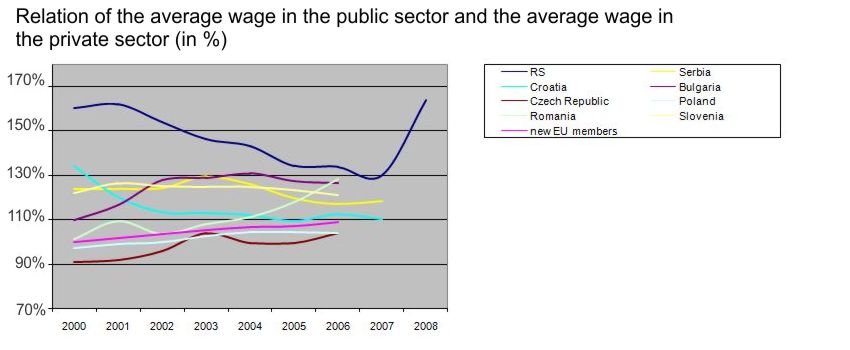The announcement by the Government of the Republic of Srpska about increasing the monthly wages of employees in public institutions to restore their incomes to 2008 levels is not all that it may seem. Here GEA provides some context related to this decision.
Doubts about the logic behind this measure are immediately raised when we consider that the the real GDP value of the Republic of Srpska is significantly below its level of GDP in 2008.
Furthermore, the Republic of Srpska has long held the dubious record among European countries experiencing economic transition of the highest difference between wages in the public and private sectors. The average wage in public administration in January of this year in B&H was 1050 BAM – a full 60.3% higher than the average wage in private sector, which amounted to 655 BAM.
Precisely in 2008, B&H introduced a large public sector wage increase of 42.5% in comparison with 2007, which is clearly shown on the given graph. (Data collected from the Republic of Srpska Institute for Statistics. The average wage in private sector was calculated as the average of wages in all sectors dominated by private ownership (data from January 2014), taking into account the number of employees per sector (data from September 2013)
Republic of Srpska’s record-breaking difference between public and private sector wages holds up even when we account for the practice of some employers paying a portion of wages in the form of “cash-in-hand” – a practice employed in other countries as well.
There are several negative consequences resulting from this high public versus private wage differential:
- The budget is heavily burdened by income allocations, which made up a staggering 44.2% of the Republic’s total 2014 budget. This burden significantly limits other budget lines.
- Comparatively high public sector wages encourage weak entrepreneurial initiative – especially among young people, who often state that their career priority is finding a job in the public sector.
- As the largest employer by far, the public sector out-competes the private sector, rendering negotiation between employers and unions in the private sector more difficult.
There is widespread agreement that this problem must be addressed. In April 2014 the RS Government announced a plan to reform the Law on Wages. GEA proposes a simple principle: That each public sector job be compensated in accordance with the level of compensation typically provided in a comparable private sector position. A lawyer employed by the Government would not be paid more than a lawyer in a private firm, for example. Even with comparable wages, public sector employment will remain most desirable due to greater workplace security, regular paychecks, fewer overtime requirements, etc. Nevertheless, young people would have greater incentives for investing time and resources into their education as well as generating and realizing entrepreneurial ideas.
Even if the Republic did not have a public-private wage gap, the question remains: Is the 27 million BAM that is being allocated to fund wages being spent wisely? Are public sector wage increases really the number one priority of the Republic?
In short, the use of these funds for wage increases bears substantial economic opportunity costs. Here are a few other areas where these funds may be more wisely spent, for example:
– Assistance to the most social vulnerable in the form of an increase in social welfare payments (the monthly payment to a person incapable of labor is currently 121 BAM,
– An increase in tax-exempt income to stimulate employment, enable wage increases in the private sector and minimize the grey economy,
– An increase in spending on programs to stimulate employment and self-employment among young people (the current youth employment rate in RS is only 12.3 %).

